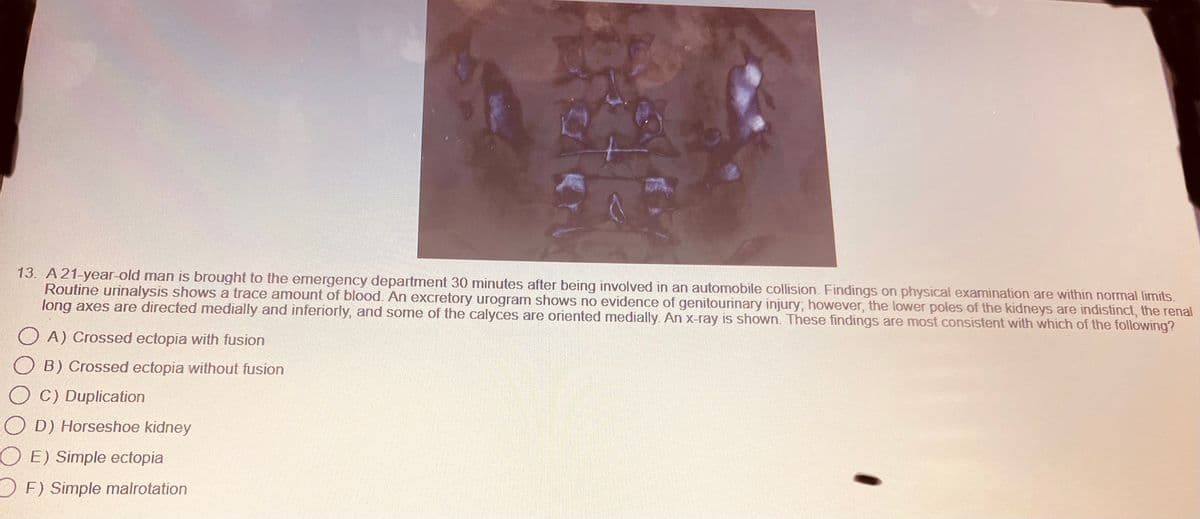13. A 21-year-old man is brought to the emergency department 30 minutes after being involved in an automobile collision. Findings on physical examination are within normal limits. Routine urinalysis shows a trace amount of blood. An excretory urogram shows no evidence of genitourinary injury, however, the lower poles of the kidneys are indistinct, the renal long axes are directed medially and inferiorly, and some of the calyces are oriented medially. An x-ray is shown. These findings are most consistent with which of the following? OA) Crossed ectopia with fusion OB) Crossed ectopia without fusion OC) Duplication D) Horseshoe kidney E) Simple ectopia F) Simple malrotation
13. A 21-year-old man is brought to the emergency department 30 minutes after being involved in an automobile collision. Findings on physical examination are within normal limits. Routine urinalysis shows a trace amount of blood. An excretory urogram shows no evidence of genitourinary injury, however, the lower poles of the kidneys are indistinct, the renal long axes are directed medially and inferiorly, and some of the calyces are oriented medially. An x-ray is shown. These findings are most consistent with which of the following? OA) Crossed ectopia with fusion OB) Crossed ectopia without fusion OC) Duplication D) Horseshoe kidney E) Simple ectopia F) Simple malrotation
Biology: The Dynamic Science (MindTap Course List)
4th Edition
ISBN:9781305389892
Author:Peter J. Russell, Paul E. Hertz, Beverly McMillan
Publisher:Peter J. Russell, Paul E. Hertz, Beverly McMillan
Chapter48: Regulating The Internal Environment
Section: Chapter Questions
Problem 6TYK: Which of the following correctly describes a part of kidney function? a. Collecting ducts dilute...
Related questions
Question

Transcribed Image Text:13. A 21-year-old man is brought to the emergency department 30 minutes after being involved in an automobile collision. Findings on physical examination are within normal limits.
Routine urinalysis shows a trace amount of blood. An excretory urogram shows no evidence of genitourinary injury, however, the lower poles of the kidneys are indistinct, the renal
long axes are directed medially and inferiorly, and some of the calyces are oriented medially. An x-ray is shown. These findings are most consistent with which of the following?
OA) Crossed ectopia with fusion
B) Crossed ectopia without fusion
OC) Duplication
OD) Horseshoe kidney
OE) Simple ectopia
OF) Simple malrotation
Expert Solution
This question has been solved!
Explore an expertly crafted, step-by-step solution for a thorough understanding of key concepts.
Step by step
Solved in 3 steps

Recommended textbooks for you

Biology: The Dynamic Science (MindTap Course List)
Biology
ISBN:
9781305389892
Author:
Peter J. Russell, Paul E. Hertz, Beverly McMillan
Publisher:
Cengage Learning

Biology: The Unity and Diversity of Life (MindTap…
Biology
ISBN:
9781337408332
Author:
Cecie Starr, Ralph Taggart, Christine Evers, Lisa Starr
Publisher:
Cengage Learning

Fundamentals of Sectional Anatomy: An Imaging App…
Biology
ISBN:
9781133960867
Author:
Denise L. Lazo
Publisher:
Cengage Learning

Biology: The Dynamic Science (MindTap Course List)
Biology
ISBN:
9781305389892
Author:
Peter J. Russell, Paul E. Hertz, Beverly McMillan
Publisher:
Cengage Learning

Biology: The Unity and Diversity of Life (MindTap…
Biology
ISBN:
9781337408332
Author:
Cecie Starr, Ralph Taggart, Christine Evers, Lisa Starr
Publisher:
Cengage Learning

Fundamentals of Sectional Anatomy: An Imaging App…
Biology
ISBN:
9781133960867
Author:
Denise L. Lazo
Publisher:
Cengage Learning

Biology: The Unity and Diversity of Life (MindTap…
Biology
ISBN:
9781305073951
Author:
Cecie Starr, Ralph Taggart, Christine Evers, Lisa Starr
Publisher:
Cengage Learning

Biology 2e
Biology
ISBN:
9781947172517
Author:
Matthew Douglas, Jung Choi, Mary Ann Clark
Publisher:
OpenStax

Anatomy & Physiology
Biology
ISBN:
9781938168130
Author:
Kelly A. Young, James A. Wise, Peter DeSaix, Dean H. Kruse, Brandon Poe, Eddie Johnson, Jody E. Johnson, Oksana Korol, J. Gordon Betts, Mark Womble
Publisher:
OpenStax College